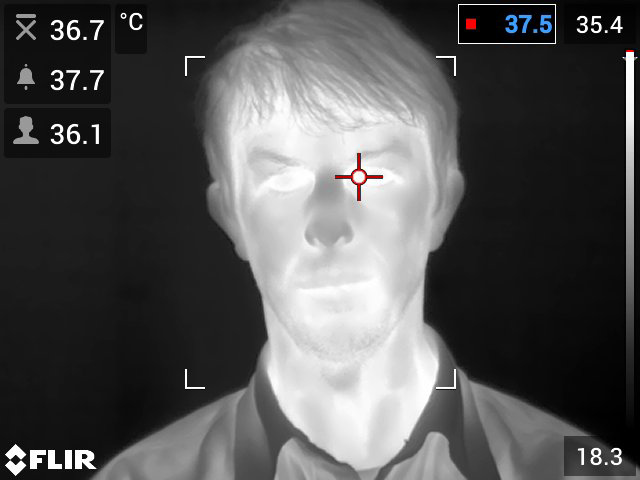Fever Screening
 Fever Screening - Normal
Fever Screening - Normal
Fever Screening
Fever screening, using a thermal camera, is a non-contact assessment for detecting Elevated Body Temperature (EBT). It cannot determine if you have a virus or infection, but it can be used to defect people that are symptomatic with (EBT), thereby reducing the spread. There are 3 international standards covering fever (i.e., febrile) screening as follows:
- IEC 80601-2-59:2017 Medical electrical equipment — Part 2-59: Particular requirements for the basic safety and essential performance of screening thermographs for human febrile temperature screening
- ISO/TR 13154:2017 Medical electrical equipment — Deployment, implementation and operational guidelines for identifying febrile humans using a screening thermograph
- ISO 80601-2-56:2017 Medical electrical equipment — Part 2-56: Particular requirements for basic safety and essential performance of clinical thermometers for body temperature measurement
The standards focus on the equipment specification, the environmental setup and operation. Here is a brief summary of the requirements. Spectrocity does not advocate the use of this material without referencing to the actual standards.
Equipment
For fever screening applications, it is critical for the thermal camera to accurately identify raised temperature within individuals. The equipment must be fit for purpose and conform to medical standards. One of the standards required by the manufacturer is ISO 13485 for medical devices. It is important when selecting equipment to consult with trained personal.
Environmental setup
The screening environment is paramount for accurate screening. The screening process must be done in a indoor, controlled environment. The standards outline a long list of recommended facilities and key requirements. Some of the key requirements are as follows:
- Ambient temperature must be controlled.
- Backdrop requirements to be non-reflective avoiding dark colours.
- Drafts, heat sources and air conditioning in the screening area should be avoided.
- Halogen, Incandescent, quartz and tungsten lighting should be avoided.
- Secondary screening, using a clinical thermometer, is required of any individual testing positive for elevated temperature.
- Ease-of-extraction of anyone who tests positive.
Operation
The camera should be setup with the correct parameters and thresholds. The following requirement should be fulfilled.
- People should be screened one-at-a-time.
- Their faces must be parallel to the camera.
- Minimum face pixel requirements should be achieved.
- Focus area: Inner eye (the region medically adjacent to the Inner Canthi).
- Eyeglasses, hair, or other items should not obstruct their faces.
- A clinical thermometer is required for verification of anyone testing positively.
- Collected data should be kept for one month and managed in accordance with GDPR.
